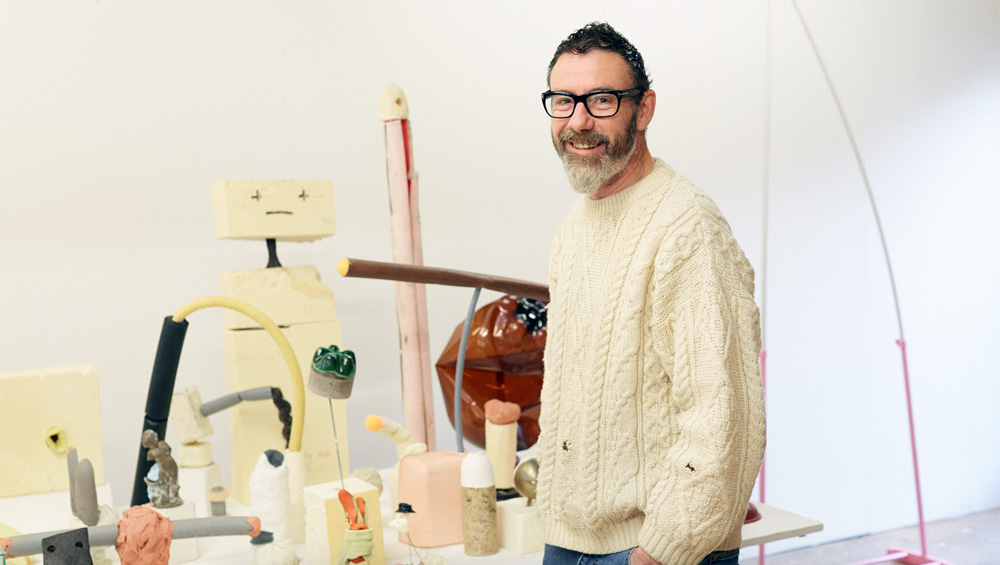
Simon English. Photograph: Jenny Lewis.
by EMILY SPICER
Simon English (b1959) emerged on to the art scene in 1994 as part of Saatchi Gallery’s Young British Art III. His work is almost entirely drawing based, serving as a visual diary of sorts, but one that taps not so much in to his daily routines as into his inner life – a subconscious permeated by popular music, relationships and gay culture. English’s practice is remarkably fluid; figures seem to pour on to the page, some taking on complex doll-like forms, while others are more tethered to realism. Whether amorphous or figurative, much of his work is imbued with eroticism and desire and, at times, pain. A wall of English’s drawings provides a deeply personal tour of tension and joy punctuated by text that thickens the meaning of his images, like cornflour added to sauce.
Through his art, English has found a way of processing life’s disappointments. “I invented this character called Let Go,” he explains. “It sort of allowed me to leap between real and fictional lives. Perhaps it’s not as earnest as it should be, but it does allow a lot of freedom.” Let Go features in English’s work as a proxy to the self, providing a means of exploring difficult issues more freely. And where personal experience forms the basis of his work, chance plays a part, too. Whether an apt line in a song on the radio, a conversation on Grindr, or a well-timed visit by a friend, fortuitous events feed English’s practice, which he tells me: “Now, more than ever, really energises me and that is how it should be, I think.”
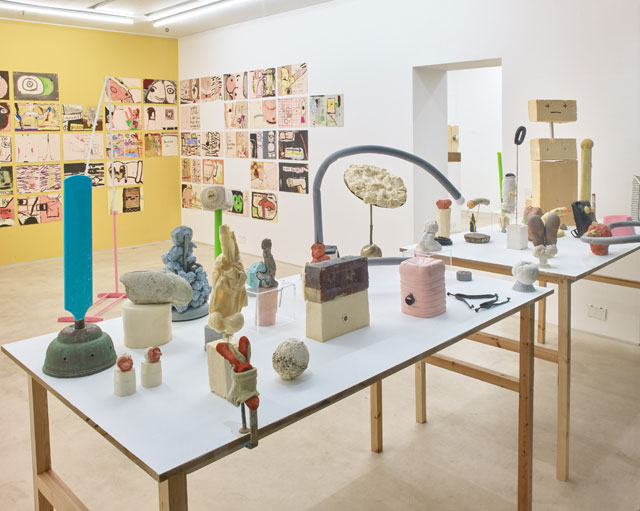
Simon English. Smile Please, 2018, installation view, Peer Gallery, London. Photograph: Jackson White.
The title of English’s current show, at Peer Gallery in Hackney, east London, is another example of the artist allowing outside influences to galvanise his work. Gallery director Ingrid Swenson picked the words “smile please” from the collection of annotated drawings and “somehow knew that would be exactly the right title,” he tells me. It’s not the first time a friend or colleague has chosen titles for English’s work. “I’m really happy handing it over,” he tells me. “And I really love this idea of it being the plaything of others and the serendipity of somebody else entering the fray.”
Emily Spicer: You were sent to boarding school aged eight, where you were given the task of drawing your parents, but you hadn’t met your father. Can you tell me about this experience?
Simon English: I arrived at boarding school knowing that art was the thing for me. It’s what I wanted, what I needed. I’d been doing it from the age of four or five as a kind of escape and vividly remember this particular project – which was a strange one really – to conjure up an image of one’s parents. It felt quite voodoo and profound, this sense of depicting a massive part of my life, which was loss, trying to conjure up this tangible image of someone. I realise in hindsight that it was quite a sexualised image and [there was] this sense of almost performing a kind of marital right. I think I was searching for a new father.
I already had a kind of proficiency in painting and I was encouraged by this amazing woman who taught French and English, called Miss Killingbeck. She was very beautiful, and she really nurtured my love of drawing. Instead of having to go to Scouts on a Wednesday afternoon, I was given the keys to the art room and I would just spread myself out on a blank sheet of paper. Weirdly enough, the houses that have resurfaced in the last few years were very present there.
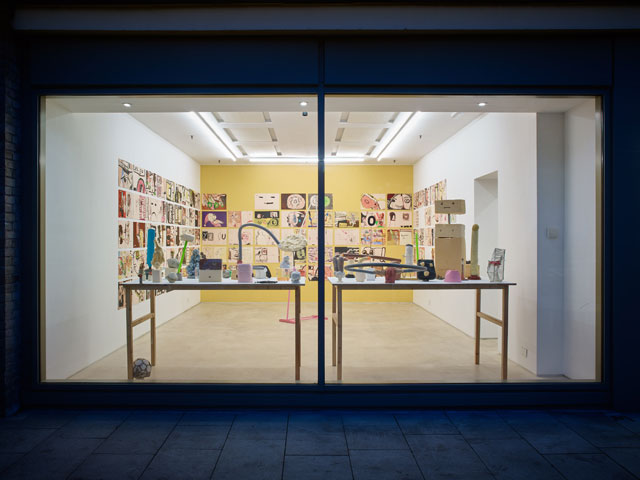
Simon English. Smile Please, 2018, installation view, Peer Gallery, London. Photograph: Jackson White.
ES: You have referred to the houses you draw as a place of safety within your work. What does that mean?
SE: It’s not just about the buildings. It’s a parallel universe, an alternative life and this is ignited in illustration and fairytales from an early age. We’re presented with these generic houses, in a sense, and I suppose mine are certainly that. So it’s kind of a safe space to explore things in. But it doesn’t have to be a house and I am restricted by what my hand wilfully wishes to do. I can never foresee anything I draw; if I do, I will destroy it and move on to something else, because it no longer interests me. It’s a weird thing, outwitting oneself with architecture.
ES: Is drawing a compulsion for you? Does it offer a kind of release? Or is it that you just have to keep that wilful hand busy?
SE: It keeps me off the streets, number one. It gives me something to do. I’m not sure what else I would do, accept real-life activities. But it is a sort of meditation; it does have to be practised. If I’m not practising, it’s amazing how that part of the brain dries up and the activity becomes estranged and odd. So, it has to be compulsive, or repetitive at least, in order to keep that wheel of belief working; otherwise, there are other things to be doing, like dipping my toes in the canal or walking. All of these things I love.
ES: That sounds rather idyllic!
SE: It does! But life is far from idyllic. Those are the highlights. Those are the threats to my working practice. But there is definitely a combination of things at work – restlessness, irritability, discontent – so the thing has to keep moving and I can never think in one pictorial way, or approach art with a logical beginning, middle and end. It has to be making itself with my eyes turned away, which requires the repetition of habit and concentration and it is also an illogical part of the brain that I need to access, which is very different from the logical brain because my intuition is, without doubt, more intelligent than my intellect.
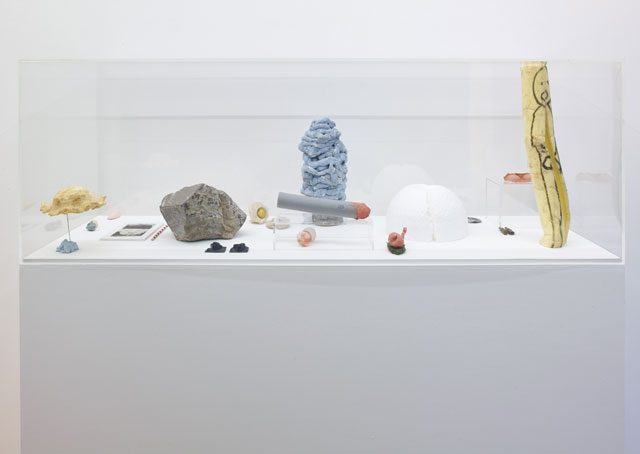
Simon English. Smile Please, 2018, installation view, Peer Gallery, London. Photograph: Jackson White.
ES: I think it is possible that creativity can be stifled through overthinking. It is as though you are doing a sort of automatic writing, in a way – that idea that the Victorians were so fond of – of releasing the subconscious on to the page.
SE: Absolutely. It is an automatic writing and an automatic drawing. If I were to go into my studio and think my way into work, it wouldn’t happen. And, of course, the surprise is part of the addiction – the desire to go somewhere I couldn’t have thought of going at the start of the day. But also the automatic writing is funny because it’s a great safe space. And things can be deleted. But I’ve learned over time to let things go a lot more, and let things be what they need to be. My work isn’t steered towards a particular audience and it doesn’t know when it’s ready, until it’s ready.
ES: Certain themes shine through in your work – longing and loss and angst, too. Is that fair to say?
SE: You’re so right! It’s very angsty at times! I completely own that word.
ES: Do you think, then, that art and pain are linked, that good art comes from a bad place? Or is that just a horrible cliche?
SE: No, I think it’s an interesting point, only in that art can come from all different places. I make art in periods of great contentment, serenity, calm, meditation, happiness, joy. But I also have to make it at times when everything is upside down and back-to-front – what I call a “dis day”, a discombobulated day, which we all get. And the interesting thing is, perhaps, that sometimes on those dis days we make works that we think are terrible, but actually they have a real integrity and truth. They speak to something beyond the normal region of control.
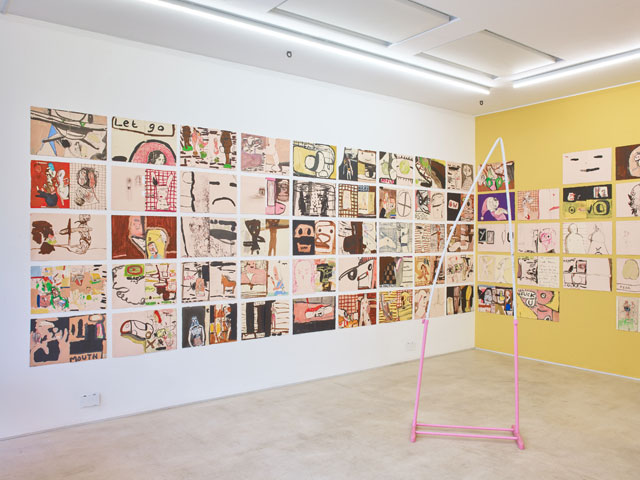
Simon English. Smile Please, 2018, installation view, Peer Gallery, London. Photograph: Jackson White.
I’m quite a joyous person, but on the one hand, I used to think I was the Sylvia Plath of Hackney, but I’ve since realised that was called alcoholism. I’ve been in a recovery programme and I’m having a very happy life at the moment. There’s a tremendous amount of joy in the work. It may not look it. Some of the drawings have been made in a period when I’ve been giving up smoking. I’ve just started again. I’ve had an endless battle over the last few years.
ES: You have said that you use words to hijack emotional space. Can you elaborate?
SE: Taking an abstract image and housing it alongside a well-known lyric is really quite empowering. I listen quite a lot to Kiss FM because it’s the same songs again and again. It just repeats itself like Groundhog Day and I like repetition – things kind of filter through. And I’m touched by songs, or by lyrics and it’s all I need sometimes to move [the work] along or to mould it, or to completely eradicate it, or hijack it, or change it. One critic described me as having visual Tourette’s, which I thought was quite interesting, because, in a way, there is constant interference from the internal and the external life.
I love the serendipity of, say, the poetry hour on BBC Radio 4, when a piece of text comes across that absolutely hits on what I’m doing. It’s a chance moment in the now space. It feels quite spine-tinglingly right, somehow, or it just has a way – like a pigment – of entering the materials. It also has a way of recording time as well, because a lot of these drawings might use text that is also about specific things and I know where I was exactly when I see that drawing. It is like a journal, almost, like a curiously fragmented Dada diary.
ES: When all your images are on the wall, altogether, arranged in rows, it looks like a truly cohesive body of work. Do you conceive of drawings individually or as part of a bigger whole? Could any one of your drawings stand alone?
SE: It varies. I did an enormous wall installation, which was 20 metres long, at MAC VAL (Musée d’Art Contemporain du Val-de-Marne) in Paris in 2013. And I very much see that as one piece. It [consists of] 100 large works and, somehow, I always felt that they needed to be kept together, which is a sort of indulgence. But what I find at the moment is that it is important to allow individual ones to go, because people want this and that, and although I see them as part of one big installation, I have to realise that there are various transmutations or possibilities.
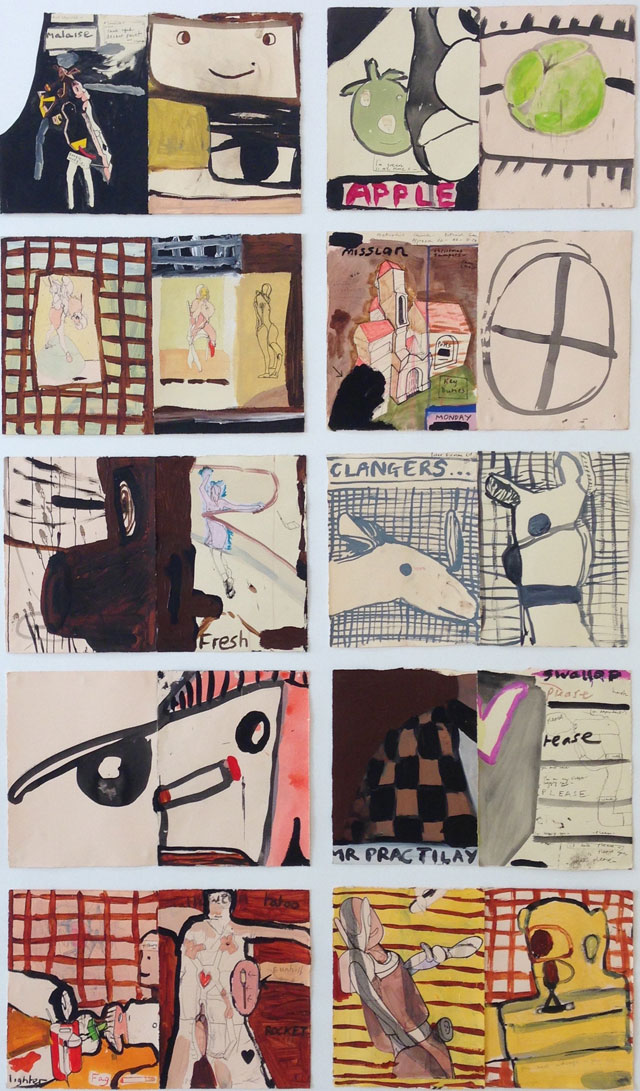
Simon English. Smile Please, 2018 (detail), installation view, Peer Gallery, London. Photograph: Emily Spicer.
ES: You have said that you don’t use a ruler, that the line is a wilful act, which is a really nice sentiment. Can you expand on that a little more?
SE: There is a little bit of schoolboy swagger in being able to draw a straight line, but, also, it’s much more complex because it requires a sort of strange, balletic concentration, which is already a tool for locking you inside the work, because it’s a meditative process. And, by the way, when I stop smoking, for the first few weeks I can’t draw a straight line to save my life.
I’ve only really realised in the last few years that the hand is a very curious machine and all drawing is, is a choreography of movement and pressure that leaves a trace. The hand is – it sounds so corny – but it is incredibly expressive and I find that it wants to do strange things at the end of a line. It either completes itself, because that’s the will and determination of that line, or it’s seeking something else. It’s a strange thing to say, but my hand is not responsible for illustrating things I already know: it’s really geared to open up things I don’t know. It is very wilful, I think – it has a life of its own and it’s strange because it’s hardwired to the subconscious and that is one of the main areas of my palette, this sort of automatism. But it’s curious. All of this is dictated by what is in my hand. If it’s a loaded brush, it’s going to open up an entirely different sensibility to a very fine line, which is already telling me, in a sense, that I need to slow things down.
ES: Is the choice of the tool that you’re using an entirely conscious one?
SE: It’s become a strangely unconscious thing. It’s become quite intuitive. It’s slightly magical. There’s something almost tarot-esque about this experience. It’s all a little bit bigger than me, and those choices are grounded in a set routine. I play a lot of games now in the studio – games about chance and consequences – but I don’t analyse them in any complex way.
ES: Recently, you have turned your hand to sculpture. Tell me a little about that transition.
SE: I’ve always loved sculpture, but I never thought it was possible or approachable, but, somehow, within my drawing I was already making sort of sculptural proposals, not expecting to put them into place. When I came back from the show in Paris at the end of 2013, I had drawn myself out of existence for a short while, so I decided to play with space and to play with objects, not expecting to go further than the odd cardboard box, intending just to find a new way of orchestrating space. I found sculpture closer to drawing than painting, and it really feels very spontaneous in a very curious way.
ES: You use found objects, or objects that have already found a place in your life, which feeds into that idea of chance in your work.
SE: And it’s quite like drawing, when images find me on a page; it’s the same thing with these objects. It’s almost like I have to go back, I have to pick these things up. I’ve lugged enormous things from the middle of Victoria Park back to my studio in Hackney. These things need to literally have a budget of nothing in order to find me, and in order to enter the drawing zone. In a similar way, without being too grandiose, I have many sculptor friends who spend absolute millions every year and I have no intention of doing that.
ES: There is a lot of pink in your work, is that a shorthand for the erotic life? Or is it just a colour that you like?
SE: I’m just totally drawn to that colour. It probably does read on all sorts of levels and some people could say that it is the colour of desire, perhaps. I’ve always loved pink, and yellow is quite new in the work. I don’t know where that has come from, but I’ve never used yellow as much as I have done in the last year. It’s a colour that I can’t wear, but pink I can. I love colour, I absolutely love it and I didn’t know that until the last few years and I’ve been using it much more vividly in a really pleasurable way.
ES: Is it too simplistic to say that your increased use of colour is a reflection of how much better you’ve felt over the past few years since giving up alcohol?
SE: Yeah, I think it is. I’m sure it is a sort of vivacity. I’m sure the act of colouring is an act of joy – it’s an act of happiness, an act of celebration and I don’t think misery reaches for bright colours. And I’m not saying that I was miserable. I’ve been very lucky to have a life that I’ve enjoyed and connected with.
• Simon English: Smile Please is at the Peer Gallery, London, until 22 September 2018.